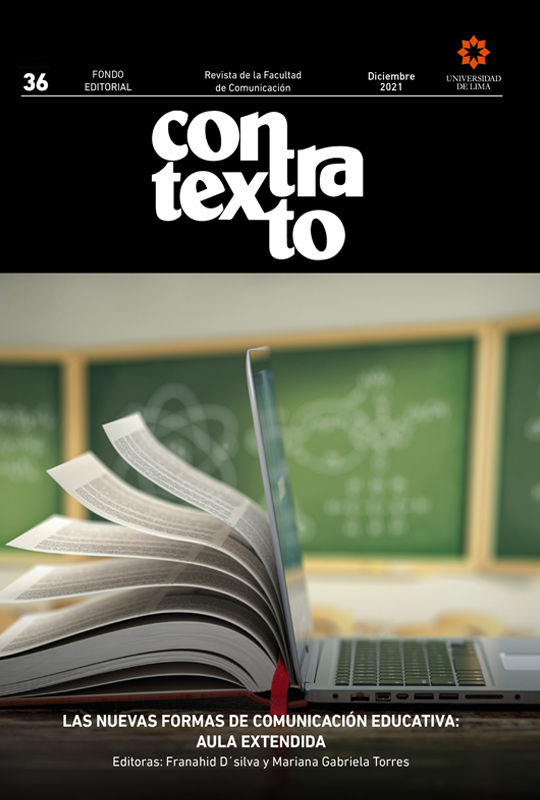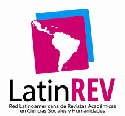Transmedia narratives in communication in times of crisis: the 2016 Ecuador earthquake
DOI:
https://doi.org/10.26439/contratexto2021.n036.5230Keywords:
natural disasters, transmedia narratives, social networks, digital press, communicationAbstract
The research focuses on analyzing transmedia narratives when reporting on an earthquake from a national digital newspaper, an international one, and also the impact of Facebook when disseminating the event. The objective is to compare the content generated about the earthquake of April 16, 2016, in Ecuador through transmedia tools in El Comercio (Ecuador) and El País (Spain), and Facebook. The aim is to know the role of the audience as prosumers of information. The methodology applied was mixed: qualitative and quantitative; the sample analyzed was 1126 informative pieces from El Comercio, 44 from El País and 1155 Facebook mentions. The need to educate and inform citizens about preventing the consequences of natural disasters and the treatment given by digital media justifies the study. The importance of having prevention measures makes this research a contribution to citizenship. The journalistic narrative is strengthened by various resources that allow portraying a story in different contexts; as shown in this research, the most used resources are still photography and video
Downloads
References
Abad-Sojos, A., Martínez-Cornejo, I., Obregón-Jiménez, K., Palacios-Segarra, D., Analuisa Lema, I., y Flores-Enríquez, J. (2018). Conocimientos, actitudes y prácticas sobre catástrofes naturales en estudiantes de Medicina de la Universidad Central del Ecuador, 2017. CIMEL, 23(1), 41-46. https://doi.org/10.23961/cimel.v23i1.1068
Alcázar, J. del. (2020). Estadísticas Facebook Ecuador. Mentinno Innovación & Lifetime Value Partners. https://bit.ly/2FNodbX
Arroyo, S., Rodríguez, M., y Pérez, R. (Eds.). (2009). Gestión de la información y comunicación en emergencias y desastres. Guía para equipos de respuesta. Organización Panamericana de la Salud. https://www.paho.org/chi/dmdocuments/GestionDeInformComunica_LowRes%20Dic%2009.pdf
Ballesteros, B. (2014). Reflexión sobre la teoría de la sociedad del riesgo. Temas Sociales, 35, 203-215. https://bit.ly/2Xzbr9z
Crovi, D., y Lozano, C. (2010). La faena de lo incierto. Incertidumbre y medios de comunicación. Universidad Nacional Autónoma de México; Sitesa.
elDiario.es, el cuarto periódico digital más leído y el que más crece. (17 de septiembre del 2020). El Diario. https://www.eldiario.es/redaccion/eldiario-cuarto-periodico-digital-leido-crece_132_6226205.html
Enríquez, R. (2016). Comprensión de la utilización de las redes sociales en las narrativas transmedia en desastres naturales. Caso: terremoto de Ecuador abril 2016 [Tesis de grado, Universidad Central del Ecuador]. https://bit.ly/3gIihyN
Escobar, M. (2003). Reseña de “La sociedad del riesgo global” de Ulrich Bech. Reis. Revista Española de Investigaciones Sociológicas, 101, 279-283. https://bit.ly/3xRypoF
Francescutti, L., Tucho, F., e Íñigo, A. (2013). El medio ambiente en la televisión española: análisis de un año de informativos. Estudios sobre el Mensaje Periodístico, 19(2), 683-701.
Islas, J. (2008). El prosumidor. El actor comunicativo de la sociedad de la ubicuidad. Palabra Clave, 11(1), 29-39. https://www.redalyc.org/articulo.oa?id=64911103
Jenkins, H. (21 de marzo del 2007). Transmedia Storytelling 101. Confessions of an Aca-Fan. http://henryjenkins.org/2007/03/transmedia_storytelling_101.html
Jenkins, H. (12 de diciembre del 2009). The Revenge of the Origami Unicorn: Seven Principles of Transmedia. Confessions of an Aca-Fan. http://henryjenkins.org/blog/2009/12/the_revenge_of_the_origami_uni.html
Lozano, C. (2009). El medio ambiente como una referencia dominante en la construcción social del acontecer catastrófico. En J. Carabaza (Ed.), Comunicación y medio ambiente. Reflexiones, análisis y propuestas (pp. 132-159). Tecnológico de Monterrey.
Lozano, C., y Amaral, F. (2018). Coberturas informativas de la prevención y del acontecer de catástrofes a través de los “manuales institucionales” dirigidos a los periodistas. Estudios Rurales, 8, 6-17.
Lozano, C., Amaral, M., y Puertas, E. (2020). Los relatos periodísticos de riesgos y catástrofes en las televisiones de España. Revista Mexicana de Investigación Educativa, 25(87), 1183-1209.
Lozano, C., y Toussaint, F. (2019). Las coberturas mediáticas del terremoto de México del 19 de septiembre del 2017. En M. Amaral y C. Lozano (Eds.), Periodismo y desastres. Múltiples miradas (pp. 121-141). Universitat Autónoma de Barcelona, Institut de la Comunicació.
Mancinas, R., y Nogales, A. (2011). Redes sociales: generalidades y aplicaciones. En R. Reig y C. Langa-Nuño (Eds.), La comunicación en Andalucía: historia, estructura y nuevas tecnologías (pp. 667-689). https://bit.ly/37fguOO
Manjón, N. H. (2020). 10 años del terremoto de Haití: la importancia de la labor enfermera en catástrofes naturales. Metas de Enfermería, 23(6), 36-37.
Marcelo, C., y Marcelo, P. (2021). Educational Influencers on Twitter. Analysis of Hashtags and Relationship Structure. Comunicar, 68, 73-83. https://doi.org/10.3916/C68-2021-06
Mendoza-Michilot, M. (2017). El rostro de los diarios digitales en el Perú. Universidad de Lima, Fondo Editorial.
Mora, V. (2014). Acercamiento al problema terminológico de la narrativa transmedia. Caracteres, 3(1), 11-41. https://bit.ly/34aOvhg
Pellegrini, S., Puente, S., y Grassau, D. (2015). La calidad periodística en caso de desastres naturales: cobertura televisiva de un terremoto en Chile. Estudios sobre el Mensaje Periodístico, 21, 249-267. https://doi.org/10.5209/rev
Pellegrini, S., Puente, S., Porath, W., Mujica, C., y Grassau, D. (2011). Valor agregado periodístico: la apuesta por la calidad de las noticias. Ediciones UC.x
Pérez-López, C. (2005). Técnicas estadísticas con SPSS 12: aplicaciones al análisis de datos. Pearson.
Quezada, M. (2020). Chanco: imaginario representado, antes y después del terremoto de 2010. F@ro: Revista Teórica del Departamento de Ciencias de la Comunicación y de la Información, 1(31), 75-93.
Renó, D. (2013). Narrativa transmedia y la “des-gobernabilidad” periodística. Comunicação y Sociedade, 34(2), 141-161. http://hdl.handle.net/11449/135243
Renó, D., Campalans, C., Ruiz, S., y Gosciola, V. (2014). Periodismo transmedia: miradas múltiples. Editorial UOC.
Rivera, J. (2020). Periodismo de datos en Ecuador. Análisis de casos: El Comercio y Plan V. Chasqui. Revista Latinoamericana de Comunicación, 1(145), 327-342. https://doi.org/10.16921/chasqui.v1i145.3813
Samaja, J. (2018). La triangulación metodológica (pasos para una comprensión dialéctica de la combinación de métodos). Revista Cubana de Salud Pública, 44(2), 431-443.
Scolari, C. A. (10 de noviembre del 2011). Narrativas transmediáticas y adaptaciones: el caso Tintin. Hipermediaciones. https://bit.ly/3nwYiVT
Scolari, C. A. (2013). Narrativas transmedia: cuando todos los medios cuentan. Deusto.
Scolari, C. A., Jiménez, M., y Guerrero, M. (2012). Narrativas transmediáticas en España, cuatro ficciones en busca de un destino “cross-media”. Comunicación y Sociedad, XXV(1), 137-163. https://bit.ly/3qON4i1
Souza-Mayerholz, M., y Martínez-Ravanal, V. (2011). La intervención de la televisión en el terremoto chileno. Comunicar, 36, 69-76. https://doi.org/10.3916/C36-2011-02-07
Suing, A. (2018). La información en la televisión del terremoto ocurrido en Ecuador en abril de 2016. Razón y Palabra, 22(1-100), 374-390. https://goo.gl/UUv4dy
Tashakkori, A., y Teddlie, C. (1998). Mixed Methodology: Combining Qualitative and Quantitative Approaches. Sage.
Teso, G., Fernández, R., Gaitán, J., Lozano, C., y Piñuel, J. (2018). Comunicación para la sostenibilidad, el cambio climático en los medios. Fundación Alternativas. https://www.fundacionalternativas.org/sostenibilidad/documentos/documentos-de-trabajo/
Toala, D., y Camino, B. (2017). Reacción de los nodos de una red social luego del terremoto en Ecuador. Conference Proceedings UTMACH, 1(1), 1038-1045. https://goo.gl/hVe55q
Toffler, A. (1981). La tercera ola. Edivisión.
Vidal, F. (1994). Los terremotos y sus causas. En F. Vidal y A. Posadas (Coords.), Los terremotos y sus causas. El estudio de los terremotos en Almería (pp. 17-38). Instituto de Estudios Almerienses. https://goo.gl/XL2PMb
Downloads
Published
Issue
Section
License
All of the works published are licensed under a CC BY 4.0 Creative Commons Attribution license. (updated on March 1st 2021)
The content of the journal may be shared in any material or format. The content may be adapted, contributed upon and transformed. Both possibilities are only permitted in so far as they complete the following conditions:
- Attribution: Credit must be given where it is due, a link to the license must be provided and changes, if made, must be indicated. This should be done in the manner deemed appropriate, without suggesting that the licensor promotes you or your use of the material.
Ownership rights
The patrimonial rights for Contratexto are published under a Creative Commons BY 4.0 license, allowing authors to keep the patrimonial rights to their work without restrictions.
If a work published in Contratexto were to be copied, distributed, spread, or any other activities contemplated in the aforementioned license, the author(s) and the journal must be mentioned visibly and expressly.
Self-archive
This journal allows and encourages authors to post items submitted to the journal on personal websites or institutional repositories both prior to and after publication, while providing bibliographic details that credit, if applicable, its publication in this journal.

















